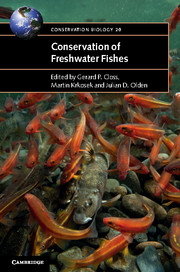Book contents
- Frontmatter
- Contents
- List of contributors
- Preface
- 1 Lost fishes, who is counting? The extent of the threat to freshwater fish biodiversity
- 2 Why are freshwater fish so threatened?
- 3 Climate change effects on freshwater fishes, conservation and management
- 4 Challenges and opportunities for fish conservation in dam-impacted waters
- 5 Chemical pollution
- 6 Multiple stressor effects on freshwater fish: a review and meta-analysis
- 7 Infectious disease and the conservation of freshwater fish
- 8 Non-indigenous fishes and their role in freshwater fish imperilment
- 9 Riparian management and the conservation of stream ecosystems and fishes
- 10 Fragmentation, connectivity and fish species persistence in freshwater ecosystems
- 11 Conservation of migratory fishes in freshwater ecosystems
- 12 Protecting apex predators
- 13 Artificial propagation of freshwater fishes: benefits and risks to recipient ecosystems from stocking, translocation and re-introduction
- 14 Freshwater conservation planning
- 15 Sustainable inland fisheries – perspectives from the recreational, commercial and subsistence sectors from around the globe
- 16 Understanding and conserving genetic diversity in a world dominated by alien introductions and native transfers: the case study of primary and peripheral freshwater fishes in southern Europe
- 17 Maintaining taxonomic skills; the decline of taxonomy – a threat to fish conservation
- 18 Synthesis – what is the future of freshwater fishes?
- Index
- References
7 - Infectious disease and the conservation of freshwater fish
Published online by Cambridge University Press: 05 December 2015
- Frontmatter
- Contents
- List of contributors
- Preface
- 1 Lost fishes, who is counting? The extent of the threat to freshwater fish biodiversity
- 2 Why are freshwater fish so threatened?
- 3 Climate change effects on freshwater fishes, conservation and management
- 4 Challenges and opportunities for fish conservation in dam-impacted waters
- 5 Chemical pollution
- 6 Multiple stressor effects on freshwater fish: a review and meta-analysis
- 7 Infectious disease and the conservation of freshwater fish
- 8 Non-indigenous fishes and their role in freshwater fish imperilment
- 9 Riparian management and the conservation of stream ecosystems and fishes
- 10 Fragmentation, connectivity and fish species persistence in freshwater ecosystems
- 11 Conservation of migratory fishes in freshwater ecosystems
- 12 Protecting apex predators
- 13 Artificial propagation of freshwater fishes: benefits and risks to recipient ecosystems from stocking, translocation and re-introduction
- 14 Freshwater conservation planning
- 15 Sustainable inland fisheries – perspectives from the recreational, commercial and subsistence sectors from around the globe
- 16 Understanding and conserving genetic diversity in a world dominated by alien introductions and native transfers: the case study of primary and peripheral freshwater fishes in southern Europe
- 17 Maintaining taxonomic skills; the decline of taxonomy – a threat to fish conservation
- 18 Synthesis – what is the future of freshwater fishes?
- Index
- References
Summary
INTRODUCTION
Infectious diseases may be an important component of the conservation of freshwater fish. Rates of infectious diseases in freshwater fish are increasing (Johnson & Paull, 2011), and are likely a consequence of the multiple anthropogenic effects that are making freshwater systems the most degraded ecosystems on Earth (Carpenter et al., 2011). More broadly, emerging diseases across taxa from all habitats tend to be related to environmental changes such as habitat fragmentation, species translocations/invasions, altered food webs, climate change or pollution (Daszak et al., 2000; Dobson & Foufopoulos, 2001; Kelly et al., 2009b). Similar processes may be at play in freshwater systems; however, these systems have received comparatively less attention than their terrestrial and marine counterparts (Johnson & Paull, 2011).
However, the role of infectious disease in species endangerment and extinction is complex and debatable (Lafferty & Gerber, 2002), and so it is not immediately clear if increasing rates of disease imply that disease is a threat to the conservation of freshwater fish. The primary reason for this is that transmission efficiency of many pathogens is linked to the density of hosts, and so when hosts become rare, it is expected that diseases will fade out and therefore may not necessarily cause extinction of their host (Grenfell & Dobson, 1995; Hudson et al., 2001). Indeed, a parasite that eliminates its host population also reduces its own fitness to zero, and so it is not clear if diseases are a direct threat to species persistence.
Furthermore, fishes have a common life-history characteristic of relatively high fecundity (egg output) but relatively low survival from egg through to reproductive maturity. Such high mortality within the life cycle is often associated with non-disease related factors such as predation. This leads to potentially complex dynamics (Hatcher et al., 2012) where different mortality processes may interact in compensatory or synergistic ways. For example, if most juvenile fish will die anyway due to predation, does an increase in infection level correspond to an increase in overall mortality? If predators selectively remove infected prey, this may actually counteract disease mortality and lead to healthier populations or alternatively by making prey easier to capture may increase overall mortality (Packer et al., 2003; Krkošek et al., 2011a). Such complex ecological dynamics entangle predator–prey, competition, and host–parasite relationships and can thus lead to multiple mortality processes that may exacerbate or dampen the effects of disease on host populations.
- Type
- Chapter
- Information
- Conservation of Freshwater Fishes , pp. 215 - 237Publisher: Cambridge University PressPrint publication year: 2015
References
- 1
- Cited by



